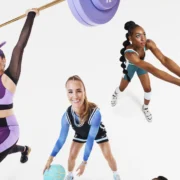CEO Corner: Dr. Emily Splichal, the Mind Behind Naboso, Explains it All About Foot Health
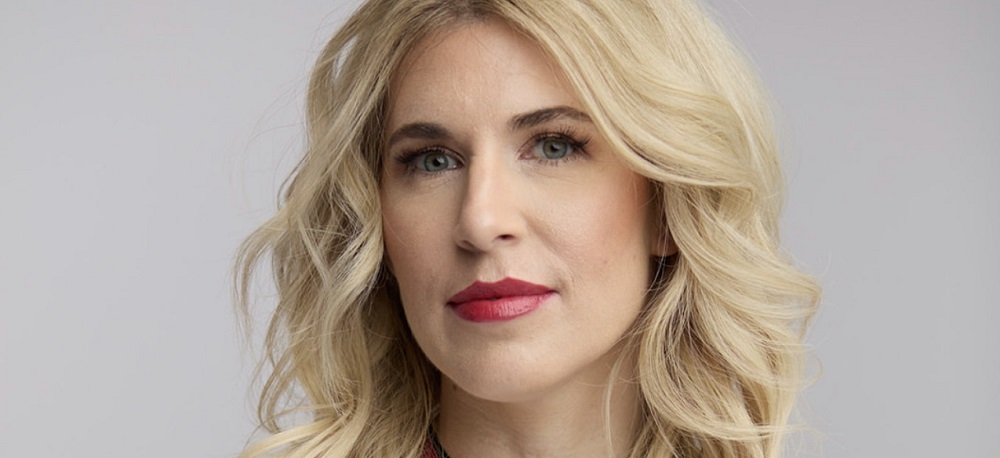
Dr. Emily Splichal is using her knowledge of all things feet to revolutionize the way we care for our very own. As a part of her master plan, she became the founder and creator of Naboso, a material science company which offers sensory products for the feet. Following up on our product review of the Naboso Foot Recovery Socks, Dr. Splichal uncovers more about her life’s work and vision, exclusively for Athletech News
We stand on them and use them to walk, run, hike and show off the latest trends in footwear. Yet, the feet remain one of the most misunderstood and understated parts of our bodies when it comes to their health. However, highly-regarded functional podiatrist and human movement specialist Dr. Emily Splichal has made it her life’s mission to change the way we care for our feet.
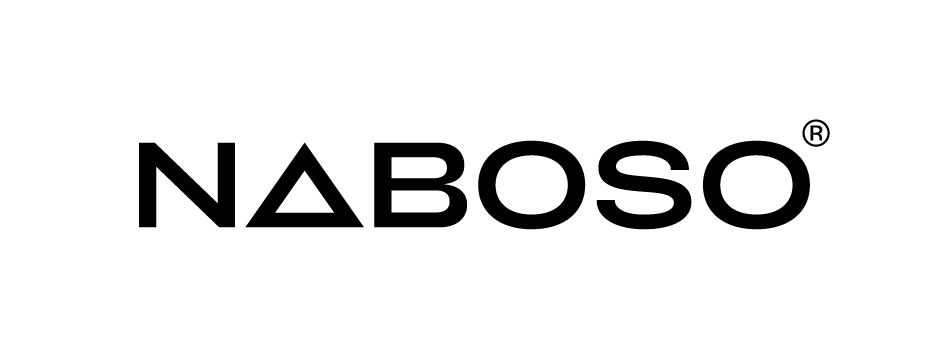
After years of study and work, Dr. Emily Splichal took her passion for podiatry one step further by inventing a line of sensory foot products called Naboso.
Naboso, which means “barefoot” in Czech, is credited as the “first-ever small nerve proprioceptive material commercially available” for the purposes of enhancing movement and stimulating the nervous system. A variety of products under Dr. Splichal’s Naboso brand does just that, including the Mind Body Mat, Neuro Foot Insoles and Sensory Sticks. One of the most distinctive Naboso features, literally felt while wearing the recovery socks, is the hard, blue material found on the socks’ insoles to stimulate the bottom of the feet and positively impact one’s range of movement.
It’s one thing to experience any of Dr. Splichal’s innovative line of proprioceptive products, but it’s quite humbling to talk with the inventor and barefoot training & rehabilitation leader about a health topic deserving of more attention. Fortunately for Athletech News, Dr. Splichal was more than willing to guide us through the origin story of her career and Naboso, along with her thoughts on the valuable ways we can all stand to take better care of our feet.
Athletech News (ATN): Your Naboso Foot Recovery Socks have been really nice to my feet, so far. Please tell us more about why you decided to go into the field of podiatry and your role
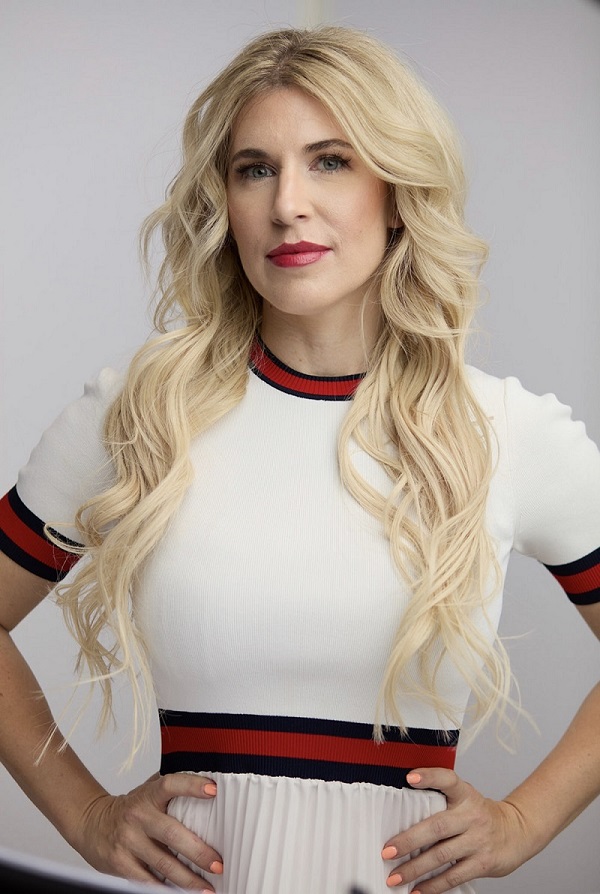
Dr. Emily Splichal: I am a functional podiatrist. I am not like most of the other podiatrists out there. I do not push patients into orthotics. I do a functional gait and movement assessment on every single patient. I look at the body from an integrative perspective, so I want to know diet, stress levels, sleep patterns, gut biomes, repetitive patterns, etc. Everything is affecting the feet. Even more so as I look primarily, or my fascination is within the sensory side of the foot, where a lot of how we’re taught about the foot in podiatry school is very biomechanical based. So that’s high arches, flat feet, pronation, supination, bones and joints that are moving, but is actually much more of the nervous system and the brain and the sensory information that’s coming in or that you’re encountering every day that ultimately shapes your movement, and that’s where a lot of research and advances in health and wellness are often within the neurological space.
ATN: How do your Naboso Recovery Socks significantly affect the feet?
Dr. Emily Splichal: Biomechanics, bones and joints do not change physics and the concept of how an elbow flexes does not change. But how you relate to your body or with pain and inflammation and the immune system and your stress levels and the way you breathe — all of that is kind of this expanding space within health, wellness, medicine. So that’s where I use sensory nervous system brain within podiatry. I look at the foot as a sensory gateway into the nervous system. It’s the only contact point between the body and the ground, so it’s very important in the way that we move, the way that we control our body. The skin on the bottom of the foot is very unique from other skin in the body, outside of the palm of your hands, based off of the types of nerves that are in that skin. And they are tactile, or touch nerves. They are responsive to very specific stimuli.
The main stimulation that it is sensitive to is vibration (is actually the biggest one). We experience vibration every time your foot strikes the ground. So impact forces, or ground reaction forces, are actually perceived as vibrations from the nerves in the bottom of your feet (and technically your fascia). And then that is what’s used to control movement and transfer energy and do all the awesome stuff we do as humans.
The other stimuli that the nerves in the bottom of your feet are responsive to is texture, but it’s really not texture. It’s two-point discrimination. The best analogy that may help people connect to two-point discrimination is Braille. We are able to read Braille because of the two points and you’re actually sensing the distance between those two points and that’s what the brain is responding to.
So, we are like Braille for your feet. The shape, height and distance of our stimulus pyramid is based off of research. It’s based off of how this nerve [“Merkel disc”] that we’re stimulating in the foot responds. The more finite the points, the more acute the stimulus will be. That’s why it’s a pyramid. And then the distance between those pyramids is also very important to get the response that we see in our users. All of our products have that same pyramidal pattern or two-point discrimination. And then we use different materials, different hardnesses of materials, different fabrics (obviously with the sock) so it’s kind of pulling compression. All of those are staying within the same stimulus, but slightly varying it so that your nervous system stays sensitive to the stimulus.
Sometimes if you have the same stimulus day [after] day [after] day you kind of block it out. [Much] like I would in New York City traffic. This is our way to say this is [a] stimulus that your foot responds to. We need to keep that stimulus, but if we keep it exactly the same, you’re gonna tune it out so then you don’t get the benefit of what our products do or what we want to achieve with our products. So that’s why you’ll see slightly different variances in the products but they stay true to that same pyramidal pattern.
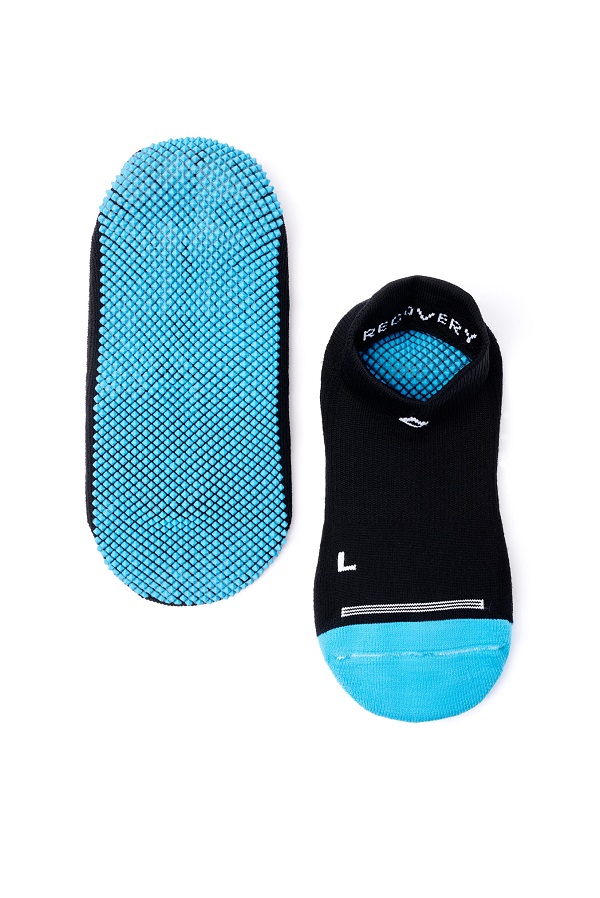
The benefits of what you can get from our products is you can activate the nerves in the bottom of the feet (when you activate the nerves that builds foot awareness which can improve foot posture and then that translates to overall movement patterns and whole body posture); you strengthen the feet (when you stimulate the nerves in the feet you strengthen the small muscles in the bottom of the feet – I like to think of the small muscles of the bottom of your feet like your core – they are your first layer of stability. Unfortunately modern footwear and orthotics actually weaken those muscles. You want to make sure that you are strengthening them by going barefoot, wearing minimal shoes and using Naboso); recovery is a big part of our product benefits as well — we provide recovery by being a mini massage to the muscles, which can feel good, we actually improve circulation to the feet and the tissue of the feet, we improve circulation to the nerves themself and we improve circulation to the skin).
Everything that I focus on as a functional podiatrist and our products through Naboso is based off of my passion for movement longevity. I’m a big anti-aging nerd. I use my passion for movement and anti-aging into this movement longevity. I wrote a book called Barefoot Strong, [which] is focused on movement longevity. I speak and write about it to try to empower patients or consumers to understand their feet and their bodies so that they can prevent a lot of the movement imbalances, dysfunctions that happen with sports overuse and then age.
ATN: How did the idea of Naboso come to you? What has the feedback for your products been thus far?
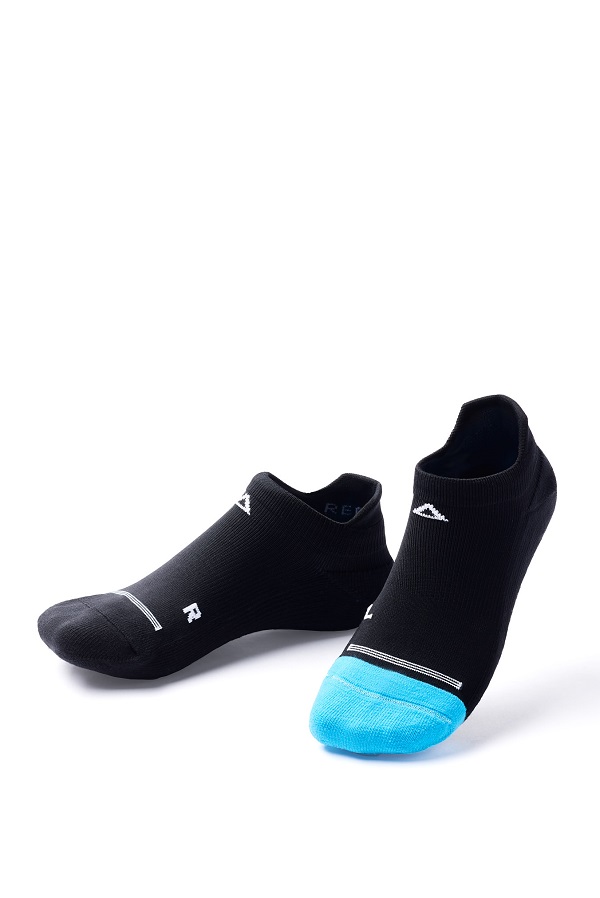
Dr. Emily Splichal: When we launched Naboso we started with one fitness mat. Think of it like a yoga mat. People loved that but then of course not everybody does barefoot movement. Not everybody works out, even though they should. So we were kind of limited to the amount of people that we would impact with this technology. So a lot of people started saying, “Oh, this is great! But what if when I’m at work, how do I get this benefit into my shoes?” So then we launched our insoles. Awesome response to that. Fast track — people would say, “Oh I love these insoles. But I wear socks. Socks are creating a barrier between my foot and the insole so there’s this issue that we were always dealing with of “Well how do I use the insoles if I wear socks?” We recommend thin socks but still the best experience is when your foot directly contacts the texture.
Some people would start putting our insoles into their sock and then put the sock on, which is innovative but not really how I would have designed something. So we started playing around with can we get the texture into the sock. Definitely not as easy as it sounds. It’s not as easy as just sewing a sock around one of our insoles. It actually took several years and now that we have figured it out, we filed a patent around our manufacturing process because it is so complicated. Now being able to deliver a sock really allows people to experience the product in a variety of ways that works for their specific lifestyle or offer it in these different interfaces that does give a similar but different experience to the nervous system. And that’s really our goal.
The recovery sock is our first sock. We are developing an all-day sock that will be a little bit lighter, different material, less compressive that people can wear throughout the day as well as working on a Pilates sock so that people can get that when they’re doing specific barefoot practices.
ATN: How often should one wear your Naboso Recovery Socks?

Dr. Emily Splichal: As a company we believe that you should be doing something to reset your feet every single day. A little bit easiest at the end of the day after you’ve stressed your feet all day and you’re either working out or standing on your feet for work, running errands, things like that. So what you’re doing, perhaps that last two hours of the day, could be longer of course, but we give this general recommendation of okay this is where we would love people to slide on our splay, roll the feel out or release the feet on our neuroballs. You’re getting just some of that more localized releasing, stretching, opening up of the foot and then that’s where the socks could come in. You [could] put on our socks and that would then be your thirty minutes to two hours of massaging and stimulating and improving circulation, etc. That’s why it’s called a recovery sock so that it can be intended to give your feet that reset at the end of the day, after a hard workout, etc.
However, people are loving them so they’re starting to wear them all day, which is totally fine. You can absolutely do that. It’s not contraindicated [from] a health and wellness perspective because there’s obviously compression socks on the market and people will wear them all day for various reasons. But, we are putting out an all-day sock which will be a little bit less compressive in that lighter material so then maybe it’s a little bit more comfortable or breathable if you are going to wear it all day.
ATN: What are your thoughts on grounding for the feet and its importance to everyday foot health?
Dr. Emily Splichal: I love grounding. I have several blogs that I’ve written about grounding. I’m a huge proponent of it. I will tell my patients, or just kind of in general, give the recommendation of grounding at least 15 minutes every day. Some of the benefits of grounding can be from re-matching or getting onto the circadian rhythm which is actually a travel hack. When you’re traveling and you go to new time zones, if you ground you’re then matching energetically into the circadian rhythm of where you now are… reducing inflammation is huge. It’s great for improving circulation, especially into the digits which is great as well and a lot of people have decreased circulation in the digits and don’t even realize it. It can strengthen the immune system especially in urban environments. It’s really good to do. The further you are away from the ground, the more acidic your environment is.
ATN: What have been the two major concerns you’ve had from patients about their feet during the COVID-19 pandemic?
Dr. Emily Splichal: The two that I’ll see are nerve inflammation — people will message me and say that they feel like the nerves in their feet are buzzing a little bit or they kind of get these tingling sensations, which are really sounding like neuropathies and neuritises, so their inflammation to the peripheral nerves and that is obviously associated with COVID or can be because of the cytokines storms and everything that is associated with COVID.
The other one is COVID toes and getting some of these tiny blood vessels that will vasospasm. It’ll look almost like a Reynaud’s — it’ll just kind of be obscure, circulatory, micro-circulatory presentations, and that’s what COVID toes is. It’s similar. It is this micro-inflammation which is where grounding is actually really good for those. Using red light therapy is really good. I’m a big fan of red light therapy for neuroinflammation, especially in the smaller nerves.
ATN: In your clinical opinion, what should people who work from home/predominantly sit more do to keep their feet healthy?
Dr. Emily Splichal: If you’re sitting at home, an environment that you can control, I hope you’re not wearing shoes. Some people love to wear shoes in their home. I would say to not wear shoes. But this is your opportunity, even though you’re sitting, to still stay connected to your feet. We have a standing mat that you could put under your desk and this is even if you’re sitting you’re barefoot sitting in a desk with your feet on the sensory mat so at least you’re staying alive to your extremities. Which is good.That’s actually, technically, really good for the brain.
Outside of that make sure you’re doing standing and movements and things like that. I will add, because I’ve just seen it a lot, that a lot of people have switched to standing desks, including at their home because they can actually control their home environment, whereas at the office it might be harder.
I see an increase in foot pain with standing desks. So, prolonged standing is something that I’m very vocal about. Obviously people know that sitting too long is not good for your body. But standing at standing desks can be just as damaging or ergonomically stressful to the body as well. People don’t necessarily think that or it surprises them sometimes, but the amount of plantar fasciitis and achilles tendonitis that I would see, especially when I was in New York City practicing and there was this sudden uptick in standing desks. So I tell people who are going to use the standing desk to stay on something that’s going to keep the feet engaged. Have the [Naboso] Neuro Ball underneath them and release the feet, be it fidgeter, put on the [Naboso] Splay, maybe you have some slippers with the [Naboso] insoles in it… try to be very variable in the stimuli and the positions that the foot would be under when you’re in a constant position.
ATN: What sort of feedback have athletes and active individuals given to you about your Naboso products?
Dr. Emily Splichal: People are loving the way that they connect to their feet. They feel that they don’t get as fatigued. They notice their feet more. We have some people who do a lot of crossfit-type lifting. They’ll notice much more energy from their feet. People will actually use them when they’re lifting and they’ll notice a difference. It really demonstrates how important the feet are. And that’s what I want our products to represent to people — I’m bringing attention to the importance of the feet. That’s always my overarching goal or message. I use the Naboso products as the conduit to do that, but at the end of the day people are appreciating the feet. Appreciate the product, but appreciate your feet.
Our feet are our foundation and it’s a very underappreciated aspect of our body when it is so deeply influential to every movement that we do, especially from an athletic perspective. There should hands down be an appreciation for feet in almost every sport. It’s really not until you get into certain sports or arts, like dance and the way that dancers so appreciate the feet. You don’t see that same thing in football, basketball, but it is! It’s so, so important to their sport.
ATN: Lastly, given your passion for anti-aging, how can we make sure to take care of our feet with this in mind within the different stages of our life?
Dr. Emily Splichal: Release your feet every day. Can you do five minutes of a foot release every day? The Neuro Ball is super easy because it splits into two domes. Leave it in your bathroom, in front of your sink, when you brush your teeth just stand on the ball. Do it twice a day — in the morning and the evening. Just that consistently every single day. Call it a couple minutes even.
Second thing is to get at least thirty minutes of barefoot or sensory stimulation a day. Wearing the [recovery] socks, walking around your home barefoot, going outside and ground. Now we’re killing two birds with one stone.
And then I try to tell people if they can to try to do two-three times a week [for] another thirty minutes of focused foot strengthening. That could be a barefoot workout (Pilates, yoga). You want your feet to be: mobile, strong, and sensory sensitive.
Our socks are beneficial for anyone who has foot pain. [They are] preventative for these conditions. We have a lot of people with neurological imbalance issues who use our products. (multiple sclerosis, Parkinson’s disease, etc.) They use them because it’ll actually support their balance and they’ll feel more stable when they’re moving.
Then [there’s also] cold feet because of the circulation (Reynaud’s syndrome, for example. Because we’re stimulating the circulation through the texture, it’s not “Oh this is a cozy warm sock and that’s why my foot doesn’t feel as cold.” It’s that we’re actually stimulating through the textures that [encourage] circulation.
Candace Cordelia is a Pennsylvania-based journalist and on-camera broadcaster/host, with a reporting background in wrestling, entertainment, and lifestyle. Her reporting work has been featured on websites and in publications such as Bustle, Pro Wrestling Illustrated, New York Daily News, am New York, ABC News, Yahoo!, Good Morning America, Madame Noire, Sister 2 Sister, etonline.com, Diva Dirt and The Everyday Fan. Her favorite workout influencers include Chloe Ting, Cassey Ho, Pamela Reif and Mary Braun. She still can’t stand burpees and Rebbl Dark Chocolate Immunity Elixir is one of her favorite post-workout protein sips. You can follow Candace on Twitter @CandaceCordelia and on Instagram @thatgirlcandace16.


